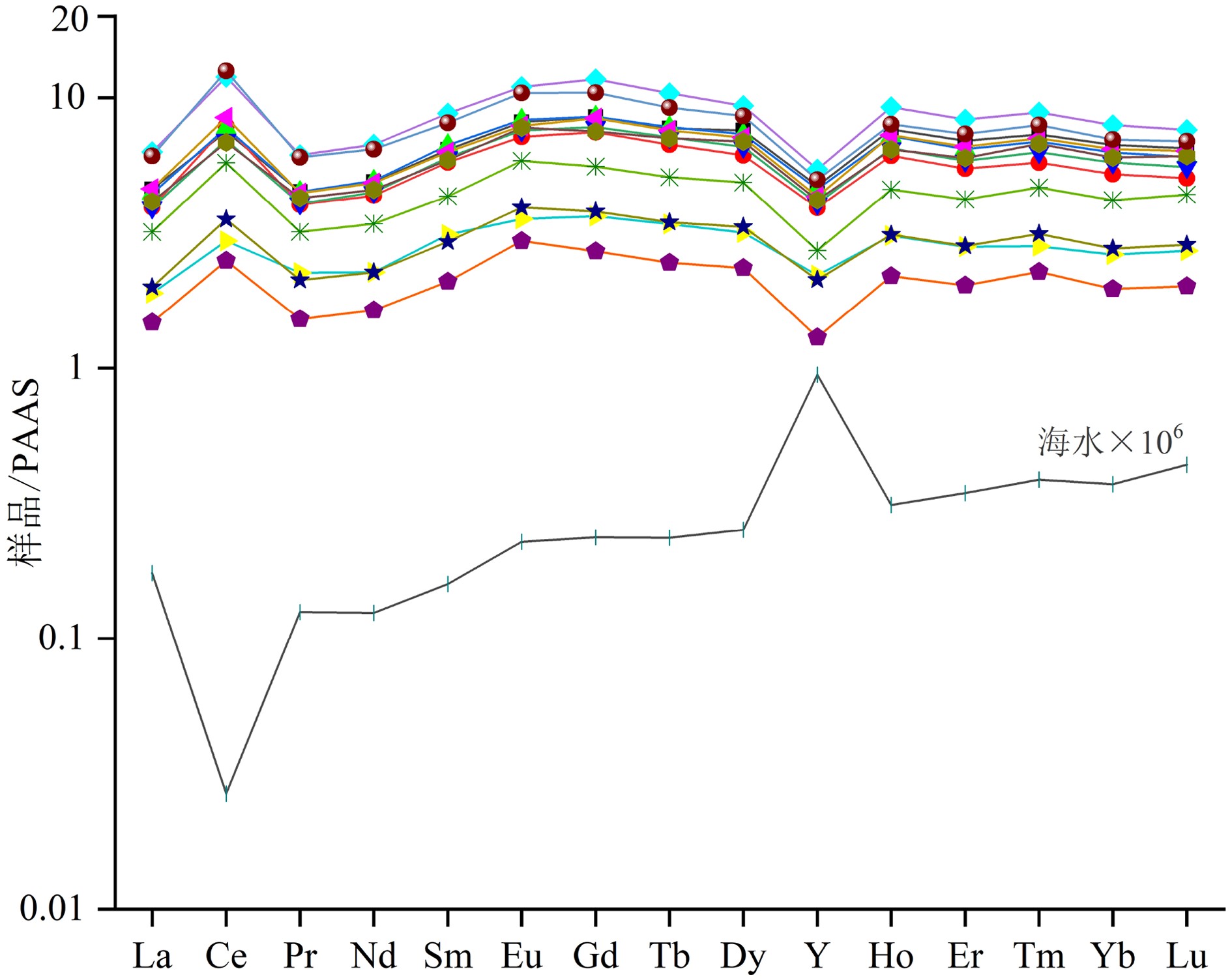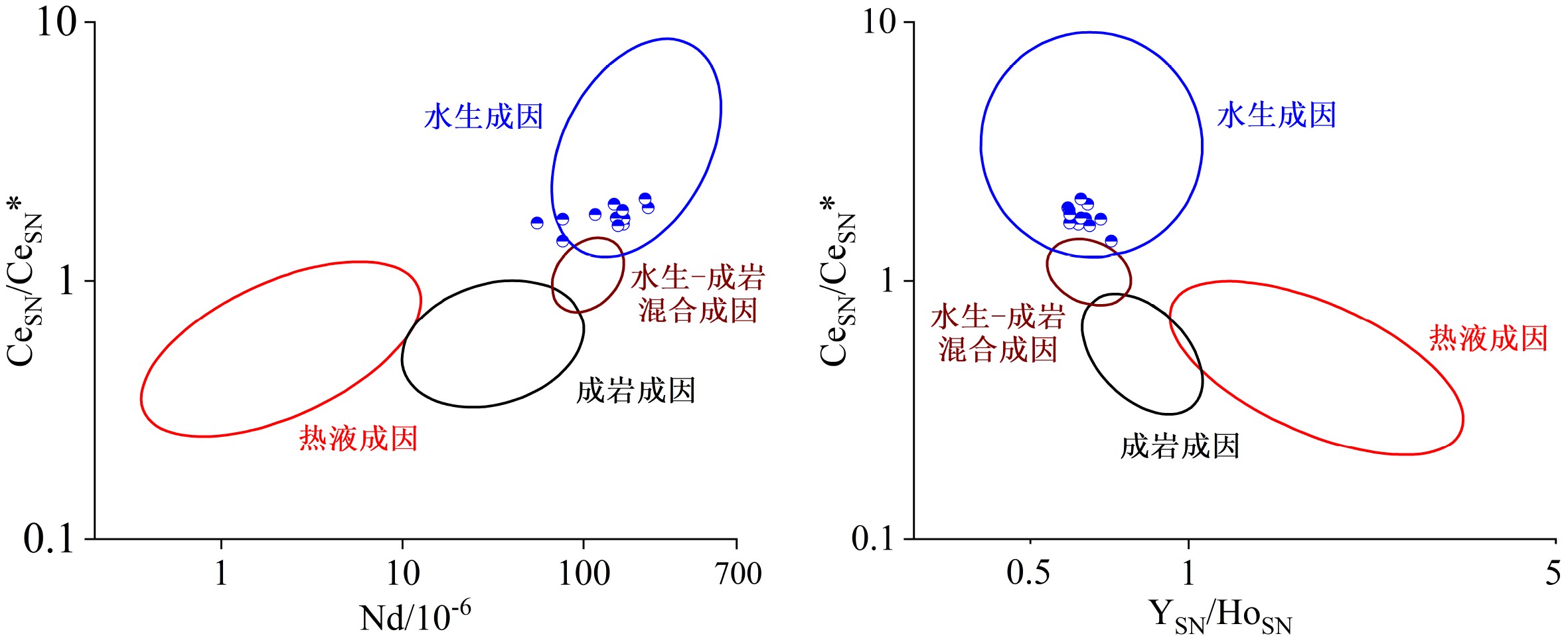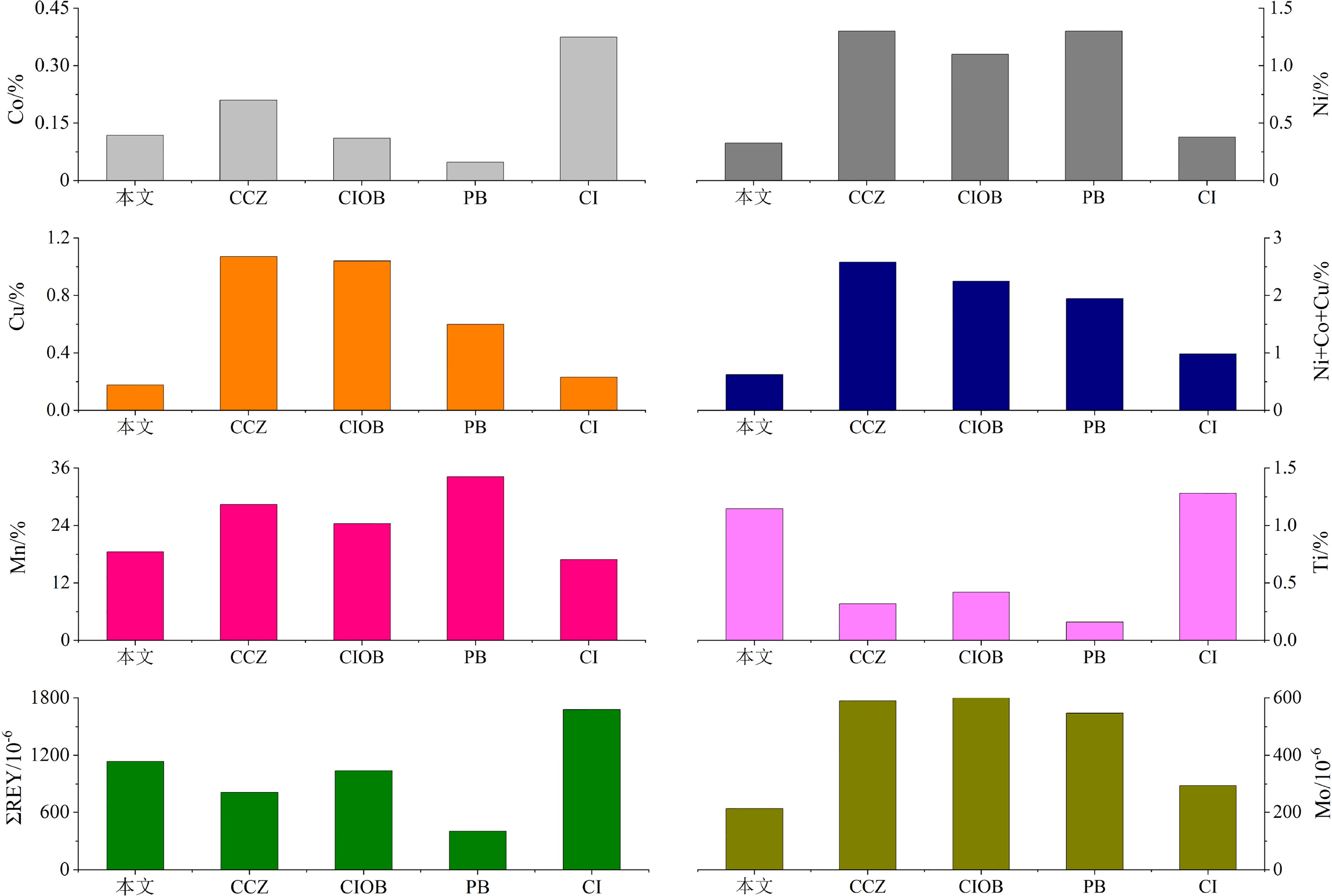Geochemical characteristics and genesis of the ferromanganese nodules in the middle western margin of the Parece Vela Basin
-
摘要:
深海铁锰结核能有效记录海域内重大地质事件和气候环境信息,且富含多种金属物质极具资源潜力,因而广受关注。通过对帕里西维拉海盆西侧边缘中段海域内新发现的12个站位铁锰结核的地球化学特征研究,发现与全球主要成矿区内的铁锰结核相比,Mn及主要赋存在锰氧化物中的Ni、Cu、Mo的含量较低(分别为8.20%~25.24%、0.11%~0.54%、0.08%~0.31%和0.01%~0.03%),主要由铁的羟基氧化物吸附的Ti,以及还会与钙磷酸盐发生耦合置换反应的REY的含量较高(分别为0.45%~1.88%、0.04%~0.19%),含量中等的Co(0.06%~0.27%)在铁锰相物质和硅酸盐相内核中分散分布。样品REY的标准化配分模式显示出明显一致的Ce正异常和Y负异常。铁锰结核从海水中捕获的Ce3+容易被氧化成难溶且不具有活性的Ce4+,Y则在结核内存在形式不稳定,容易发生解吸,致使Ce和Y分别呈现出相对于其他REY逐步富集和亏损的特征。研究区形成时间较晚,铁锰结核生长发育的时间不足,且四周地形较高,缺乏与外界连通的水道,阻碍了诸如来自南极的富氧底层流的大规模进入。区域内结核样品主要为水成型,成岩成因组分的供给太低,降低了主要有用组分的含量。以上诸多因素可能会导致区域内的铁锰结核难以富集成矿。
Abstract:Deep-sea ferromanganese nodules have been widely recognized as important records of the geological events and the climatic and environmental changes of deep oceans. They are also commonly regarded as potential resources in near future for their richness in a variety of valuable metals. In this paper, 12 stations of ferromanganese nodule are newly discovered from the middle of western margin of the Parece Vela Basin and samples collected and analyzed for their geochemical characteristics. These ferromanganese nodules are low in Mn, Ni, Cu and Mo (8.20%~25.24%, 0.11%~0.54%, 0.08%~0.31% and 0.01%~0.03%, respectively), high in Ti, REY (0.45%~1.88% and 0.04%~0.19%, respectively)and moderate in Co (0.06%~0.27%) when compared to the high potential areas of the global oceans such as CCZ, CIOB, PB and CI. The Ni, Cu and Mo are strongly enriched in manganese oxides, but the Ti and REY are mainly absorbed from ocean water by the iron oxyhydroxides, and the REY3+ with a monovalent element of similar size are easily replaced through coupled substitution by Ca2+ from the Ca phosphates in the iron oxyhydroxides. The Ce and Y show pronounced positive and negative anomalies in the REYSN patterns, respectively. The Ce3+ oxidation and Ce4+ fixation occur easily on the surface of the ferromanganese nodules. Once the Ce3+ in the ferromanganese nodules is oxidized to Ce4+, it is usually less mobile and will participate less in exchange reactions with the surrounding seawater. With time, this oxidative scavenging of Ce results in the preferential accumulation of redox-sensitive Ce relative to the non-redox-sensitive REY, but part of the Y is desorbed easily from the ferromanganese nodule surface, which produces positive Ce anomalies and negative Y anomalies. The research area is relatively young, and the growth of the ferromanganese nodules is not sufficient. Moreover, the surrounding terrain of the Parece Vela Basin is relatively high and there are less gateways connecting with the outside, which prevents the large-scale entry of the cold, dense and dissolved oxygen-rich bottom water such as Antarctic bottom water. The ferromanganese nodules of the region is dominated by hydrogenetic precipitation. However, the supply of the diagenetic precipitation components is too low, which will reduce the contents of valuable metals in the research aera. Therefore, it is low in resource potential.
-
Key words:
- ferromanganese nodules /
- Parece Vela Basin /
- genesis /
- enrichment patterns
-

-
表 1 铁锰结核内主量元素及主要有用组分间的相关系数矩阵
Table 1. Pearson correlation coefficient matrix for major and valuable metal elements contained in the studied ferromanganese nodules
Al Ca Fe K Mg Mn Na Si Ti P Co Cu Mo Ca 0.01 Fe −0.12 0.91 K 0.57 −0.42 −0.54 Mg −0.24 −0.77 −0.61 0.22 Mn −0.78 0.17 0.30 −0.50 0.33 Na 0.27 −0.32 −0.38 0.69 0.52 −0.01 Si 0.60 −0.59 −0.71 0.67 0.05 −0.85 0.13 Ti −0.10 0.85 0.88 −0.56 −0.60 0.23 −0.25 −0.68 P −0.29 0.85 0.91 −0.64 −0.48 0.43 −0.29 −0.83 0.92 Co −0.51 −0.17 −0.09 −0.38 0.19 0.19 0.00 −0.25 0.25 0.25 Cu −0.61 −0.49 −0.35 −0.21 0.79 0.67 0.21 −0.33 −0.38 −0.14 0.32 Mo −0.55 0.23 0.27 −0.58 0.26 0.89 −0.06 −0.80 0.27 0.41 0.12 0.60 Ni −0.53 −0.28 −0.17 −0.48 0.62 0.58 0.01 −0.44 −0.06 0.12 0.53 0.84 0.66 表 2 铁锰结核内REY与主量元素间的相关系数矩阵
Table 2. Pearson correlation coefficient matrix for REY and major elements contained in the studied ferromanganese nodules
Al Ca Fe K Mg Mn Na P Si Ti La −0.15 0.92 0.93 −0.63 −0.66 0.29 −0.36 0.95 −0.73 0.97 Ce −0.14 0.89 0.92 −0.58 −0.68 0.22 −0.35 0.93 −0.67 0.98 Pr −0.13 0.92 0.93 −0.63 −0.68 0.25 −0.39 0.95 −0.70 0.96 Nd −0.12 0.92 0.94 −0.62 −0.67 0.27 −0.37 0.95 −0.71 0.96 Sm −0.08 0.94 0.95 −0.60 −0.68 0.25 −0.38 0.95 −0.70 0.94 Eu −0.12 0.92 0.94 −0.62 −0.63 0.28 −0.34 0.96 −0.73 0.96 Gd −0.10 0.94 0.96 −0.60 −0.67 0.28 −0.36 0.95 −0.72 0.95 Tb −0.09 0.94 0.95 −0.60 −0.65 0.29 −0.36 0.95 −0.72 0.94 Dy −0.09 0.93 0.93 −0.61 −0.62 0.31 −0.33 0.95 −0.74 0.94 Y 0.00 0.94 0.91 −0.55 −0.66 0.26 −0.32 0.91 −0.69 0.90 Ho −0.07 0.94 0.94 −0.58 −0.63 0.32 −0.32 0.93 −0.74 0.92 Er −0.09 0.94 0.93 −0.59 −0.62 0.34 −0.32 0.93 −0.75 0.92 Tm −0.11 0.93 0.92 −0.61 −0.58 0.36 −0.30 0.95 −0.77 0.93 Yb −0.09 0.93 0.92 −0.60 −0.59 0.36 −0.30 0.94 −0.76 0.92 Lu −0.11 0.92 0.91 −0.62 −0.57 0.36 −0.30 0.94 −0.77 0.93 ΣREY −0.13 0.92 0.94 −0.60 −0.68 0.25 −0.35 0.95 −0.70 0.98 -
[1] Hein J R, Koschinsky A. Deep-ocean ferromanganese crusts and nodules[M]//Holland H D, Turekian K K. Treatise on Geochemistry. 2nd ed. Oxford: Elsevier, 2014: 273-291.
[2] Hein J R, Koschinsky A, Kuhn T. Deep-ocean polymetallic nodules as a resource for critical materials [J]. Nature Reviews Earth & Environment, 2020, 1(3): 158-169.
[3] Kuhn T, Wegorzewski A, Rühlemann C, et al. Composition, formation, and occurrence of polymetallic nodules[M]//Sharma R. Deep-Sea Mining: Resource Potential, Technical and Environmental Considerations. Cham: Springer International Publishing, 2017: 23-63.
[4] Mukhopadhyay R, Ghosh A K, Iyer S D. The Indian Ocean Nodule Field: Geology and Resource Potential[M]. 2nd ed. Oxford: Elsevier, 2018: 1-413.
[5] Flint J M. Description of manganese nodules collected by the U. S. S. NERO during survey for a trans-pacific cable[Z]. PANGAEA, https://doi.org/10.1594/PANGAEA.847719.
[6] Bezrukov P L, Skornyakova N S, Murdmaa I O, et al. (Appendix) Chemical composition of Fe-Mn nodules from the Pacific Ocean[Z]. PANGAEA, https://doi.org/10.1594/PANGAEA.735163.
[7] Glockhoff C. Annotated record of the detailed examination of Mn deposits from ANTIPODE Expedition stations[Z]. PANGAEA, https://doi.org/10.1594/PANGAEA.858155.
[8] Party S S. Annotated record of the detailed examination of Mn deposits from PROA Expedition stations[Z]. Scripps Institution of Oceanography, UC San Diego, PANGAEA, https://doi.org/10.1594/PANGAEA.860231.
[9] Skornyakova N S, Zenkevich N L. (Table 2) Abundance of nodules on the bottom surface, data from grab samples[Z]. P. P. Shirshov Institute of Oceanology, Russian Academy of Sciences, Moscow, PANGAEA, https://doi.org/10.1594/PANGAEA.734939.
[10] Tomoda Y. Description of manganese nodules and crust collected from the Hakuho Maru Cruise KH-71-1, January-March, 1971, East Mariana, Caroline and Philippine Basins[Z]. PANGAEA, https://doi.org/10.1594/PANGAEA.857960.
[11] NOAA. (National Oceanic and Atmospheric Administration, USA). Index to marine and lacustrine geological samples[Z]. http://www.ngdc.noaa.gov/geosamples/showsample.jspimlgs=imlgs0201090;0201089;0201079;0150668;0146610;0146609;0146605.
[12] 陈穗田, Stüben D. 菲律宾海的锰结壳和锰结核[J]. 海洋学报, 1997, 19(4):109-116
CHEN Suitian, Stüben D. Manganese crusts and nodules in the Philippine Sea [J]. Acta Oceanologica Sinica, 1997, 19(4): 109-116.
[13] 何良彪. 马里亚纳海脊-西菲律宾海盆铁锰结核的地球化学[J]. 科学通报, 1991, 36(14):1190-1193
HE Liangbiao. Geochemical characteristics of Fe-Mn nodules and crusts from the Mariana ridge and the west Philippine basin [J]. Chinese Science Bulletin, 1991, 36(14): 1190-1193.
[14] Usui A, Graham I J, Ditchburn R G, et al. Growth history and formation environments of ferromanganese deposits on the Philippine Sea Plate, northwest Pacific Ocean [J]. Island Arc, 2007, 16(3): 420-430. doi: 10.1111/j.1440-1738.2007.00592.x
[15] Party Shipboard Scientific. Initial reports of the deep sea drilling project leg 59: 4 site449: west side of the parece vela basin[R]. 1981.
[16] 吴时国, 范建柯, 董冬冬. 论菲律宾海板块大地构造分区[J]. 地质科学, 2013, 48(3):677-692 doi: 10.3969/j.issn.0563-5020.2013.03.008
WU Shiguo, FAN Jianke, DONG Dongdong. Discussion on the tectonic division of the Philippine Sea Plate [J]. Chinese Journal of Geology, 2013, 48(3): 677-692. doi: 10.3969/j.issn.0563-5020.2013.03.008
[17] Sdrolias M, Roest W R, Müller R D. An expression of Philippine Sea plate rotation: the Parece Vela and Shikoku Basins [J]. Tectonophysics, 2004, 394(1-2): 69-86. doi: 10.1016/j.tecto.2004.07.061
[18] Okino K, Ohara Y, Fujiwara T, et al. Tectonics of the southern tip of the Parece Vela Basin, Philippine Sea Plate [J]. Tectonophysics, 2009, 466(3-4): 213-228. doi: 10.1016/j.tecto.2007.11.017
[19] 殷征欣, 李正元, 沈泽中, 等. 西太平洋帕里西维拉海盆不对称性发育特征及其成因[J]. 吉林大学学报: 地球科学版, 2019, 49(1):218-229
YIN Zhengxin, LI Zhengyuan, SHEN Zezhong, et al. Asymmetric geological developments and their geneses of the Parece Vela Basin in Western Pacific Ocean [J]. Journal of Jilin University: Earth Science Edition, 2019, 49(1): 218-229.
[20] Tani K, Dunkley D J, Ohara Y. Termination of backarc spreading: zircon dating of a giant oceanic core complex [J]. Geology, 2011, 39(1): 47-50. doi: 10.1130/G31322.1
[21] 张臻, 李三忠. 雅浦沟-弧体系构造演化过程[J]. 海洋地质与第四纪地质, 2019, 39(5):138-146
ZHANG Zhen, LI Sanzhong. Tectonic evolution of the Yap trench-arc system [J]. Marine Geology & Quaternary Geology, 2019, 39(5): 138-146.
[22] Yamashita M, Tsuru T, Takahashi N, et al. Fault configuration produced by initial arc rifting in the Parece Vela Basin as deduced from seismic reflection data [J]. Island Arc, 2007, 16(3): 338-347. doi: 10.1111/j.1440-1738.2007.00594.x
[23] Lee I, Ogawa Y. Bottom-current deposits in the Miocene–Pliocene Misaki Formation, Izu forearc area, Japan [J]. Island Arc, 1998, 7(3): 315-329. doi: 10.1111/j.1440-1738.1998.00192.x
[24] Xiong Z F, Li T G, Algeo T, et al. Paleoproductivity and paleoredox conditions during late Pleistocene accumulation of laminated diatom mats in the tropical West Pacific [J]. Chemical Geology, 2012, 334: 77-91. doi: 10.1016/j.chemgeo.2012.09.044
[25] 中国大洋矿产资源调查研究开发协会. GB/T 17229-1998 大洋多金属结核矿产勘查规程[S]. 北京: 中国标准出版社, 1998.
China Ocean Mineral Resources Investigation, Research and Development Association. GB/T 17229-1998 The expertise for oceanic polymetallic nodules survey[S]. Beijing: China Standard Press, 1998.
[26] 中华人民共和国国家质量监督检验检疫总局, 中国国家标准化管理委员会. GB/T 20260-2006 海底沉积物化学分析方法[S]. 北京: 中国标准出版社, 2006.
General Administration of Quality Supervision, Inspection and Quarantine of the People's Republic of China. GB/T 20260-2006 Chemcial analysis methods for marine sediment[S]. Beijing: China Standard Press, 2006.
[27] Paul S A L, Volz J B, Bau M, et al. Calcium phosphate control of REY patterns of siliceous-ooze-rich deep-sea sediments from the central equatorial Pacific [J]. Geochimica et Cosmochimica Acta, 2019, 251: 56-72. doi: 10.1016/j.gca.2019.02.019
[28] Mclennan S M. Rare earth elements in sedimentary rocks: influence of provenance and sedimentary processes [J]. Reviews in Mineralogy and Geochemistry, 1989, 21(1): 169-200.
[29] Broecker W S. A need to improve reconstructions of the fluctuations in the calcite compensation depth over the course of the Cenozoic [J]. Paleoceanography, 2008, 23(1): PA1204.
[30] Van Andel T H. Mesozoic/Cenozoic calcite compensation depth and the global distribution of calcareous sediments [J]. Earth and Planetary Science Letters, 1975, 26(2): 187-194. doi: 10.1016/0012-821X(75)90086-2
[31] Banerjee R, Roy S, Dasgupta S, et al. Petrogenesis of ferromanganese nodules from east of the Chagos Archipelago, Central Indian Basin, Indian Ocean [J]. Marine Geology, 1999, 157(3-4): 145-158. doi: 10.1016/S0025-3227(98)00156-X
[32] Bonatti E, Kraemer T, Rydell H. Classification and genesis of submarine iron-manganese deposits[M]//Horn D R. Ferromanganese Deposits on the Ocean Floor. Washington: National Science Foundation, 1972.
[33] Halbach P, Scherhag C, Hebisch U, et al. Geochemical and mineralogical control of different genetic types of deep-sea nodules from the Pacific Ocean [J]. Mineralium Deposita, 1981, 16(1): 59-84.
[34] Bau M, Schmidt K, Koschinsky A, et al. Discriminating between different genetic types of marine ferro-manganese crusts and nodules based on rare earth elements and yttrium [J]. Chemical Geology, 2014, 381: 1-9. doi: 10.1016/j.chemgeo.2014.05.004
[35] Josso P, Pelleter E, Pourret O, et al. A new discrimination scheme for oceanic ferromanganese deposits using high field strength and rare earth elements [J]. Ore Geology Reviews, 2017, 87: 3-15. doi: 10.1016/j.oregeorev.2016.09.003
[36] Bau M. Scavenging of dissolved yttrium and rare earths by precipitating iron oxyhydroxide: experimental evidence for Ce oxidation, Y-Ho fractionation, and lanthanide tetrad effect [J]. Geochimica et Cosmochimica Acta, 1999, 63(1): 67-77. doi: 10.1016/S0016-7037(99)00014-9
[37] Bau M, Koschinsky A, Dulski P, et al. Comparison of the partitioning behaviours of yttrium, rare earth elements, and titanium between hydrogenetic marine ferromanganese crusts and seawater [J]. Geochimica et Cosmochimica Acta, 1996, 60(10): 1709-1725. doi: 10.1016/0016-7037(96)00063-4
[38] Halbach P, Friedrich G, Von Stackelberg U. The Manganese Nodule Belt of the Pacific Ocean–Geological Environment Nodule Formation, and Mining Aspects[M]. Stuttgart: Ferdinand Enke Verlag, 1988: 254.
[39] Jung H S, Lee C B. Growth of diagenetic ferromanganese nodules in an oxic deep-sea sedimentary environment, northeast equatorial Pacific [J]. Marine Geology, 1999, 157(3-4): 127-144. doi: 10.1016/S0025-3227(98)00154-6
[40] Deng Y N, Ren J B, Guo Q J, et al. Rare earth element geochemistry characteristics of seawater and porewater from deep sea in western Pacific [J]. Scientific Reports, 2017, 7: 16539. doi: 10.1038/s41598-017-16379-1
[41] Zhang J, Nozaki Y. Rare earth elements and yttrium in seawater: ICP-MS determinations in the East Caroline, Coral Sea, and South Fiji basins of the western South Pacific Ocean [J]. Geochimica et Cosmochimica Acta, 1996, 60(23): 4631-4644. doi: 10.1016/S0016-7037(96)00276-1
[42] Hein J R, Spinardi F, Okamoto N, et al. Critical metals in manganese nodules from the Cook Islands EEZ, abundances and distributions [J]. Ore Geology Reviews, 2015, 68: 97-116. doi: 10.1016/j.oregeorev.2014.12.011
[43] 姜学钧, 姚德, 翟世奎. 过渡金属元素Cu、Co、Ni在铁锰结核(壳)中富集的控制因素[J]. 海洋地质与第四纪地质, 2004, 24(3):41-48
JIANG Xuejun, YAO De, ZHAI Shikui. Factors controlling the concentration of the transition metals Cu, Co and Ni in the ferromanganese deposits: an overview [J]. Marine Geology & Quaternary Geology, 2004, 24(3): 41-48.
[44] Foster A L, Klofas J M, Hein J R, et al. Speciation of energy critical elements in marine ferromanganese crusts and nodules by principal component analysis and least-squares fits to XAFS spectra[C]//American Geophysical Union, Fall Meeting 2011.2011.
[45] Wasylenki L E, Weeks C L, Bargar J R, et al. The molecular mechanism of Mo isotope fractionation during adsorption to birnessite [J]. Geochimica et Cosmochimica Acta, 2011, 75(17): 5019-5031. doi: 10.1016/j.gca.2011.06.020
[46] Peacock C L, Sherman D M. Crystal-chemistry of Ni in marine ferromanganese crusts and nodules [J]. American Mineralogist, 2007, 92(7): 1087-1092. doi: 10.2138/am.2007.2378
[47] Bau M, Koschinsky A. Oxidative scavenging of cerium on hydrous Fe oxide: evidence from the distribution of rare earth elements and yttrium between Fe oxides and Mn oxides in hydrogenetic ferromanganese crusts [J]. Geochemical Journal, 2009, 43(1): 37-47. doi: 10.2343/geochemj.1.0005
[48] Marcus M A, Toner B M, Takahashi Y. Forms and distribution of Ce in a ferromanganese nodule [J]. Marine Chemistry, 2018, 202: 58-66. doi: 10.1016/j.marchem.2018.03.005
[49] 姜学钧, 林学辉, 姚德, 等. 稀土元素在水成型海洋铁锰结壳中的富集特征及机制[J]. 中国科学: 地球科学, 2011, 54(2):197-203 doi: 10.1007/s11430-010-4070-4
JIANG Xuejun, LIN Xuehui, YAO De, et al. Enrichment mechanisms of rare earth elements in marine hydrogenic ferromanganese crusts [J]. Science China Earth Sciences, 2011, 54(2): 197-203. doi: 10.1007/s11430-010-4070-4
[50] Azami K, Hirano N, Machida S, et al. Rare earth elements and yttrium (REY) variability with water depth in hydrogenetic ferromanganese crusts [J]. Chemical Geology, 2018, 493: 224-233. doi: 10.1016/j.chemgeo.2018.05.045
[51] Liao J L, Sun X M, Li D F, et al. New insights into nanostructure and geochemistry of bioapatite in REE-rich deep-sea sediments: LA-ICP-MS, TEM, and Z-contrast imaging studies [J]. Chemical Geology, 2019, 512: 58-68. doi: 10.1016/j.chemgeo.2019.02.039
[52] Petersen S, Krätschell A, Augustin N, et al. News from the seabed – Geological characteristics and resource potential of deep-sea mineral resources [J]. Marine Policy, 2016, 70: 175-187. doi: 10.1016/j.marpol.2016.03.012
[53] Dutkiewicz A, Judge A, Müller R D. Environmental predictors of deep-sea polymetallic nodule occurrence in the global ocean [J]. Geology, 2020, 48(3): 293-297. doi: 10.1130/G46836.1
[54] Xiao C H, Wang Y H, Lin J. Constraints of magnetostratigraphic and mineralogical data on the provenance of sediments in the Parece Vela Basin of the western Pacific [J]. Journal of Asian Earth Sciences, 2020, 196: 104373. doi: 10.1016/j.jseaes.2020.104373
[55] 许东禹. 大洋矿产地质学[M]. 北京: 海洋出版社, 2013.
XU Dongyu. Ocean Mineral Geology[M]. Beijing: Ocean Press, 2013.
[56] 袁良榕, 张恩. 大洋多金属结核的矿物学特征与南极底流(AABW)活动[J]. 矿物学报, 2018, 38(5):481-489
YUAN Liangrong, ZHANG En. Mineralogical characteristics of oceanic polymetallic nodules and the activities of the Antarctic bottom water (AABW) [J]. Acta Mineralogica Sinica, 2018, 38(5): 481-489.
-




 下载:
下载:


